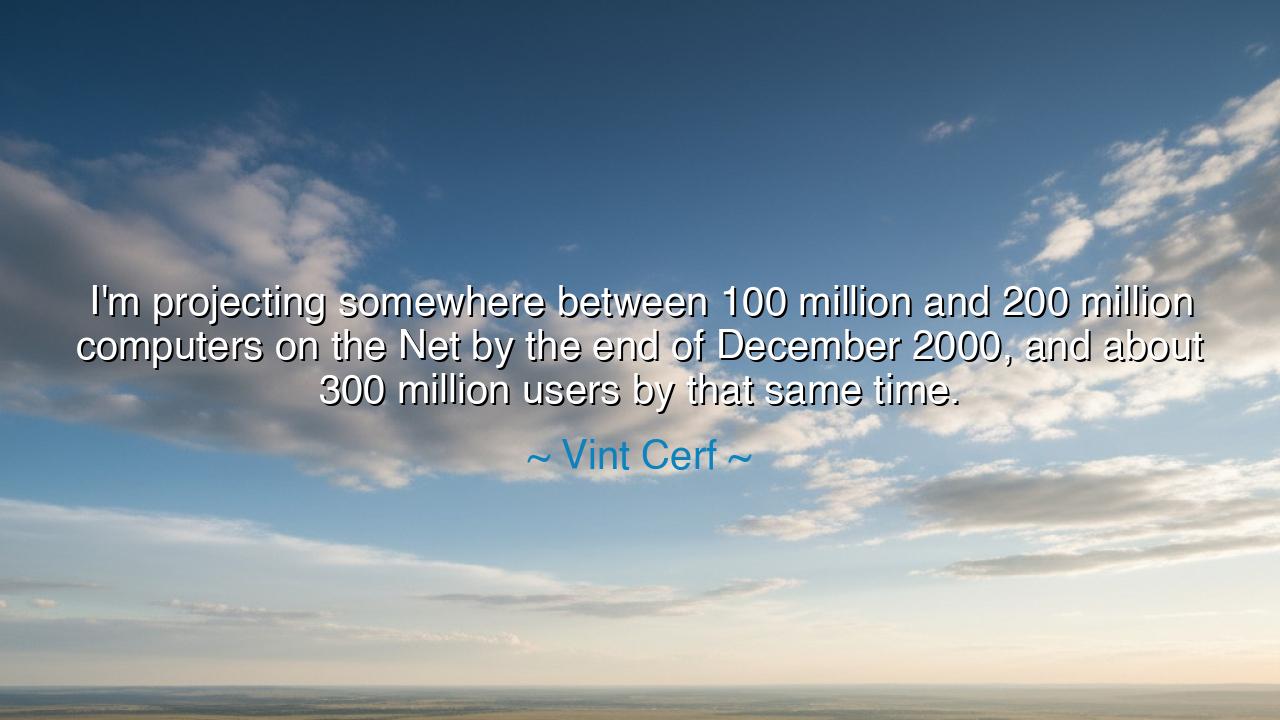
I'm projecting somewhere between 100 million and 200 million
I'm projecting somewhere between 100 million and 200 million computers on the Net by the end of December 2000, and about 300 million users by that same time.






When Vint Cerf uttered the words, “I’m projecting somewhere between 100 million and 200 million computers on the Net by the end of December 2000, and about 300 million users by that same time,” he did not simply offer a prediction; he spoke as a visionary, a prophet of the digital age, charting a course for a world that was rapidly transforming before his very eyes. At the time of his statement, the internet was still in its early stages, a network of dreams and possibilities that few could truly grasp. Cerf, known as one of the fathers of the internet, understood that the world was on the brink of an extraordinary shift — a shift so profound that it would redefine how humanity connected, shared, and communicated. His words were not merely about numbers; they were about change, about a vision of a future where the world would no longer be bound by physical distance, but instead united through the power of technology.
To understand Cerf’s vision, we must first recognize the world before the internet. It was a time when communication was bound by wires, by letters, by phones that could only reach as far as the wires would extend. The thought of a global network, where every individual, every community, could communicate instantaneously, was nothing more than a dream for many. But Cerf and his colleagues saw beyond the limitations of their time. They saw a web that would grow, not only in size but in influence, eventually connecting billions of people across the globe, forever altering the way we lived and worked.
Cerf’s projection of 100 to 200 million computers on the Net by the turn of the millennium was audacious, yet in hindsight, it now seems almost prophetic. At the time, the internet was far from ubiquitous. It was a tool used primarily by researchers, academics, and tech enthusiasts. The idea of 300 million users was a staggering number, almost impossible to imagine. And yet, by December 2000, the internet had exploded beyond even Cerf's bold prediction, with well over 360 million people connected. The internet was not just a tool; it had become an integral part of daily life — a thread that wove itself into the fabric of every community, every nation.
In this vision, we see a prophecy of connectivity, a dream that was realized not just through technology, but through the willingness of humanity to embrace the power of communication and collaboration. Tim Berners-Lee, the British computer scientist who invented the World Wide Web, had a similar vision of creating a platform that would allow individuals to share information freely. The internet became the great equalizer, a space where ideas, knowledge, and opportunities could flow across boundaries, transforming societies in ways that seemed unimaginable at the time.
But as with all powerful forces, this transformation came with both blessings and challenges. The internet, while a tool for global connection, also brought with it dangers — misinformation, loss of privacy, and the rise of a digital divide that still separates many from the benefits of the digital world. Cerf’s prediction was realized in ways both profound and complicated. The internet has connected billions, but it has also led to new forms of isolation, new questions about identity, and new dilemmas about the ethical use of technology.
The lesson we take from Cerf’s words is not just about the growth of technology, but about the potential for technology to shape the future. Cerf’s projection was not a mere statistical guess; it was a vision of how technology could create a more connected, informed world. And yet, as we have learned, technology is a double-edged sword. We must use the power of the internet not only to connect, but to ensure that connection is used for good, for understanding, and for progress. The rapid growth of the digital age demands that we constantly examine how we use these tools — for progress, for collaboration, and for the betterment of humanity.
Practical actions for those living in the digital age:
-
Harness the power of connection — use the internet not just for convenience, but for meaningful collaboration and learning.
-
Balance progress with ethics — as we innovate, let us also be mindful of the impact of technology on privacy, security, and human relationships.
-
Stay informed — continually educate yourself about the rapidly evolving world of technology and the ways in which it shapes our societies.
-
Use technology for good — ensure that the power of the internet is used to spread truth, not misinformation, to build bridges, not walls.
For as Vint Cerf foresaw, the internet is a force that can shape humanity’s future, for better or for worse. It is a tool that offers boundless potential, but it is up to us to guide its use with wisdom, care, and a sense of purpose. As we stand in the age of constant digital evolution, we must remember the power of connection, but also the responsibility that comes with it.






AAdministratorAdministrator
Welcome, honored guests. Please leave a comment, we will respond soon